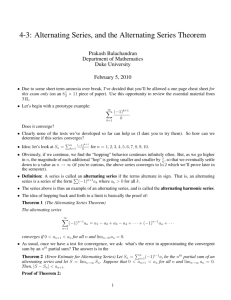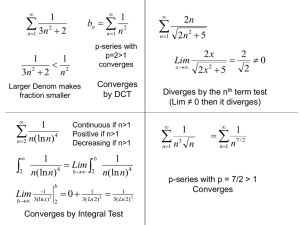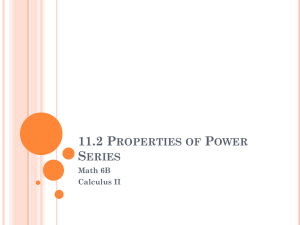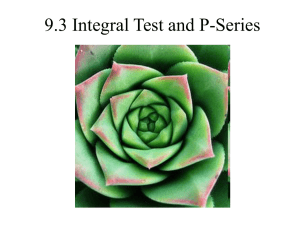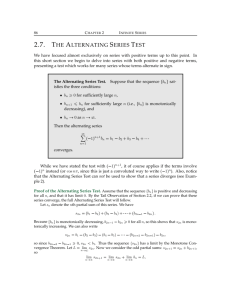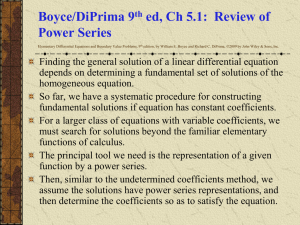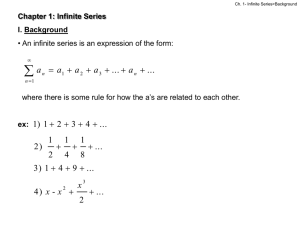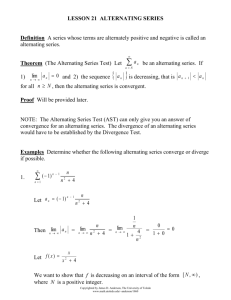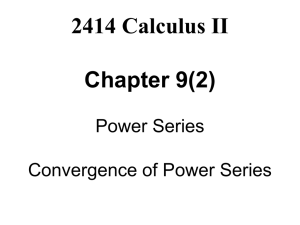Ratio and Root Tests
advertisement
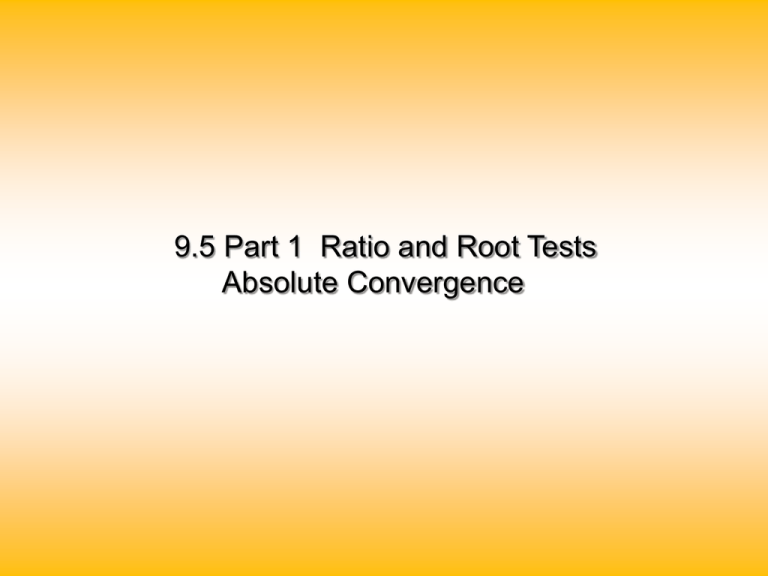
9.5 Part 1 Ratio and Root Tests Absolute Convergence You’ve all seen the Harmonic Series n 1 1 n converges which ? despite the fact that lim n diverges 1 0 n which only proves that a series might converge. What if we were to alternate the signs of each term? 1 1 1 2 1 3 1 4 1 5 1 ... 6 How would we write this using Sigma notation? This is called an Alternating Series The signs of the terms alternate. Does this series converge?. 1 n 1 n 1 1 n 1 1 1 2 1 3 1 4 1 5 1 ... 6 1 1 Notice that each addition/subtraction is 3 4 1 1 partially canceled by the next one. 5 6 …smaller and smaller… The series converges as do all Alternating Series whose terms go to 0 Alternating Series The signs of the terms alternate. This series converges by the Alternating Series Test. 1 n 1 n 1 1 n 1 1 1 2 1 3 1 4 1 5 1 ... 6 Alternating Series Test For the series: 1 n 1 n 1 an If a n 1 a n and lim a n 0 n Then the series converges This is called the Alternating Harmonic Series which as you can see converges…unlike the Harmonic Series Since each term of a convergent alternating series moves the partial sum a little closer to the limit: 1 3 n 1 n 1 is what kind of a series? What is the sum of this series? 3 Very good! A geometric series. 0 . 75 4 Try adding the first four terms of this series: 1 3 n 1 n 1 1 1 3 1 9 1 27 20 . 740741 27 Which is not far from 0.75…but how far? Since each term of a convergent alternating series moves the partial sum a little closer to the limit: 1 3 n 1 n 1 1 1 1 3 1 9 20 . 740741 27 27 Which is not far from 0.75…but how far? 1 . 740741 . 75 Which means what? 108 1 108 3 n5 1 n 1 1 81 1 Can we agree that 81 1 243 1 243 1 ... 729 1 729 ... 1 81 ? 1 81 1 243 1 ... 729 1 leads us to this: 81 Alternating Series Estimation Theorem For a convergent alternating series, the truncation error is less than the first missing term, and is the same sign as that term. Which means that for an alternating series… If k terms were generated then the error would be no larger than term k + 1 1 k n an S and an S k where k < n 1 n 1 then 1 n S k S a k 1 in which S k S is the truncation error 1 1 81 243 1 ... 729 1 81 leads us to this: Alternating Series Estimation Theorem For a convergent alternating series, the truncation error is less than the first missing term, and is the same sign as that term. For example, let’s go back to the first four terms of our series: 1 3 n 1 Answer: n 1 1 1 3 1 9 1 27 What is the maximum error between this approximation and the actual sum of infinite terms? 1 81 1 Which is bigger than the actual error which we determined to be 108 Since each term of a convergent alternating series moves the partial sum a little closer to the limit: Alternating Series Estimation Theorem For a convergent alternating series, the truncation error is less than the first missing term, and is the same sign as that term. Answer: 1 81 So what does this answer tell us? It simply means that the 1 error will be no larger than 81 That is why it is commonly referred to as the Error Bound Since each term of a convergent alternating series moves the partial sum a little closer to the limit: Alternating Series Estimation Theorem For a convergent alternating series, the truncation error is less than the first missing term, and is the same sign as that term. This is also a good tool to remember because it is easier than the LaGrange Error Bound…which you’ll find out about soon enough… Muhahahahahahaaa! Geometric series have a constant ratio between terms. Other series have ratios that are not constant. If the absolute value of the limit of the ratio between consecutive terms is less than one, then the series will converge. This is called the RATIO TEST For the series a n n if lim n a n 1 L then an if L 1 the series converges. if L 1 the series diverges. This test is ideal for factorial terms if L 1 the series may or may not converge. This also works for the nth root of the nth term. This is called the ROOT TEST(Ex. 57 pg. 508) For the series a n n if lim n n an L then if L 1 the series converges. if L 1 the series diverges. if L 1 the series may or may not converge. Absolute Convergence If an converges, then we say If an a converges, then converges absolutely. n a n converges. If the series formed by taking the absolute value of each term converges, then the original series must also converge. “If a series converges absolutely, then it converges.” Conditional Convergence If a n a n converges but a n diverges, then we say that converges conditionally If a n diverges, then 1 n 1 n 1 1 n a n diverges. 1 1 1 2 1 3 1 4 The Alternating Harmonic Series is a perfect example of Conditional Convergence 1 5 1 6 ...
